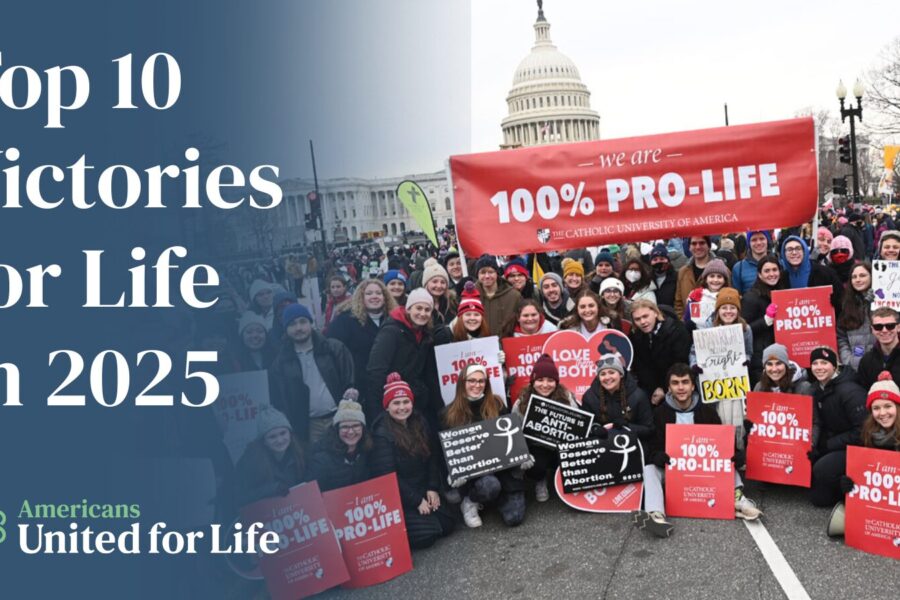On December 1st, the Supreme Court heard oral arguments in the anti-abortion case, Dobbs v. Jackson. It was a historic moment and exceeded our expectations.
Dobbs presented the most comprehensive oral argument the Supreme Court has heard on abortion. The discussion touched upon the spectrum of abortion issues, including stare decisis, the undue burden standard’s viability line, women’s social reliance upon abortion, the distorted legal history of abortion, federalism, and the impact of safe haven laws.
Dobbs v. Jackson Oral Arguments
Dobbs v. Jackson is primed to overrule Roe v. Wade and nearly fifty years of a federal constitutional travesty that manufactured a woman’s right to abort her unborn child.
As Mississippi Solicitor General Scott Stewart poignantly argued before the Supreme Court: “Roe v. Wade and Planned Parenthood v. Casey haunt our country. They have no basis in the Constitution. They have no home in our history or traditions. They’ve damaged the democratic process. They’ve poisoned the law. They’ve choked off compromise. For 50 years, they’ve kept this Court at the center of a political battle that it can never resolve. And 50 years on, they stand alone. Nowhere else does this Court recognize a right to end a human life.”
The Bottom Line: Dobbs Is A Powerful Challenge To Roe And Casey
Dobbs challenges Casey’s undue burden standard and Roe’s purported abortion right. The case concerns Mississippi’s Gestational Age Act, which limits abortions after fifteen weeks gestation to medical emergencies and cases of severe fetal disability incompatible with life. Both the district court and Fifth Circuit Court of Appeals held the Act was unconstitutional, acting as a ban on a woman’s right to a pre-viability abortion. The case is now before the Supreme Court on the issue of “[w]hether all previability prohibitions on elective abortions are unconstitutional.”
Dobbs not only implicates Casey’s undue burden standard, which relies upon an arbitrary viability line, but also Roe’s legitimacy in fabricating abortion as a constitutional right.
What Were Each Parties Arguments?
Mississippi’s Argument (Dobbs)
Mississippi argued the Court should reverse Roe and Casey and return the abortion issue to the states. According to the State: “The Constitution places its trust in the people. On hard issue after hard issue, the people make this country work. Abortion is a hard issue. It demands the best from all of us, not a judgment by just a few of us. When an issue affects everyone and when the Constitution does not take sides on it, it belongs to the people.”
Jackson Women’s Health Organization’s Argument
Jackson Women’s Health Organization, the abortion clinic, contended the Act is “flatly unconstitutional under decades of precedent.” According to the abortion clinic: (1) stare decisis presents “an especially high bar” for overruling Roe, and Mississippi has not passed this bar, (2) the Supreme Court correctly decided Casey and Roe in protecting a woman’s liberty interest in abortion, and (3) under a social reliance theory, “eliminating or reducing the right to abortion will propel women backwards.”
Federal US Government Argument (Supporting Jackson Women’s Health)
The United States participated in oral argument as amicus curiae in support of the abortion clinic. According to the federal government, “That guarantee that the state cannot force a woman to carry a pregnancy to term and give birth has engendered substantial individual and societal reliance.” “If this Court renounces the liberty interests recognized in Roe and reaffirmed in Casey, it would be an unprecedented contraction of individual rights and a stark departure from principles of stare decisis.”
The Supreme Court Justices’ Questions In Dobbs
Chief Justice John Roberts’ Questions
Chief Justice Roberts delved into the legal concept of viability. The Chief Justice noted that Justice Blackmun, Roe’s author, indicated the viability line was dicta (the non-binding part of a legal opinion) in his papers. Casey nevertheless determined the viability line was the most central holding of Roe, largely “because [the viability line] was pretty much all that was left after [the Justices] were done dealing with the rest of [Roe].” Similarly, the Chief Justice indicated that “as far as viability goes, I don’t see what that has to do with the question of choice at all.”
Markedly, the Chief Justice indicated that a fifteen-week ban “[is] not a dramatic departure from viability. It is the standard that the vast majority of other countries have.” The Chief Justice noted that the United States shared the viability standard with the People’s Republic of China and North Korea.
Justice Clarence Thomas’ Questions
Justice Thomas asked probing questions about where the purported abortion right appears in the Constitution. He questioned whether it made a difference “that this is the only constitutional right that involves the taking of a life.”
Justice Thomas also posed a hypothetical question about Ferguson v. Charleston, in which South Carolina had convicted a woman of criminal child neglect after she had ingested cocaine during a post-viability pregnancy. He asked whether the state would have the same interest if the circumstances had occurred in a pre-viability abortion.
Justice Stephen Breyer’s Questions
Justice Breyer emphasized stare decisis during the oral argument. He questioned whether this case should rise to the level of a “watershed case” that overruled a strong, politically divisive precedent. Justice Breyer expressed concerns that overruling Roe would hurt the political perception of the Supreme Court.
Justice Samuel Alito’s Questions
Justice Alito clarified the abortion clinic presented a zero-sum game with “no half-measures” and, under the abortion clinic’s position, the Court must reaffirm Roe and Casey or overrule them in their entirety.
The Justice questioned whether women have the same interest pre- and post-viability. He noted “viability is dependent on medical technology and medical practice. It has changed. It may continue to change.”
The Justice also forced a concession from the United States about reliance theories in egregiously wrong decisions. In Plessy v. Ferguson, for example, “the south built up a whole society based on the idea of white supremacy. So there was a lot of reliance. It was…improper reliance. It was reliance on an egregiously wrong understanding of what equal protection means.”
Justice Sonia Sotomayor’s Questions
Justice Sotomayor expressed concern about the “public perception that the Constitution and its reading are just political acts.” The Justice argued that overruling Roe and Casey would call into question other substantive due process cases, such as Griswold v. Connecticut, Lawrence v. Texas, and Obergefell v. Hodges.
Justice Sotomayor also noted that even though the Constitution does not enumerate an abortion right, other principles also do not explicitly appear in the Constitution.
When Mississippi argued Casey has not accounted for advancements in fetal medicine over the past thirty years, including the medical understanding of fetal pain, Justice Sotomayor claimed the Daubert standard would not admit evidence of fetal pain. The Justice compared fetal pain to brain-dead individuals whose bodies may respond to external stimuli. Justice Sotomayor further questioned Mississippi, asking “How is your interest [in prenatal life] anything but a religious view?”
Justice Elena Kagan’s Questions
Justice Kagan discussed stare decisis and how the doctrine “prevent[s] people from thinking this Court is a political institution that will go back and forth depending on what part of the public yells loudest and…prevent[s] people from thinking that the Court will go back and forth depending on changes to the Court’s membership.”
The Justice noted for nearly fifty years, Roe and Casey have struck a balance between a woman’s interest in bodily autonomy and the state’s interest in protecting prenatal life.
Justice Kagan, however, appeared open to compromise, questioning whether the Court could take an intermediate position by discarding the viability line, but retaining Casey’s undue burden standard.
Justice Neil Gorsuch’s Questions
Justice Gorsuch noted that Casey itself did not follow stare decisis principles in rejecting Roe’s trimester framework and adopting the undue burden standard, a test which was virtually unknown in the law previous to Casey. Similarly, the Supreme Court did not follow stare decisis in adopting a benefits-burdens analysis in Whole Woman’s Health v. Hellerstedt or subsequently splintering over whether the same benefits-burdens analysis applies to abortion litigation in June Medical Services LLC v. Russo.
According to Justice Gorsuch, the undue burden standard has been unworkable, and if the Supreme Court rejects the viability line, he questions whether there is “any other intelligible principle that the Court could choose?”
Justice Brett Kavanaugh’s Questions
Justice Kavanaugh clarified that Mississippi was not arguing that “the [Supreme] Court somehow has the authority to itself prohibit abortion or that this Court has the authority to order the states to prohibit abortion.”
According to Justice Kavanaugh’s inquiry, “the Constitution is silent and, therefore, neutral on the question of abortion….the Constitution is neither pro-life nor pro-choice on the question of abortion but leaves the issue for the people of the states or perhaps Congress to resolve in the democratic process.”
In terms of stare decisis, Justice Kavanaugh noted that some of the most important cases in the Supreme Court’s history were cases that overruled precedent.
Justice Amy Coney Barrett’s Questions
Justice Barrett examined a woman’s reliance interests under abortion. She questioned whether an abortion right “is grounded primarily in the bearing of the child, in the carrying of a pregnancy, and not so much looking forward into the consequences on professional opportunities and work-life and economic burdens.”
The Justice further noted that stare decisis is “not an inexorable command and that there are some circumstances in which overruling is possible,” such as in Brown v. Board of Education and West Coast Hotel Co. v. Parrish.
Justice Barrett also posed a hypothetical to the abortion clinic, questioning whether a state constitution limiting abortions after twenty-seven weeks gestation would be unconstitutional if the state used an undue burden standard. The hypothetical invoked Roe’s trimester framework, and Justice Barrett indicated the hypothetical’s 27-week line and Casey’s viability line were both arbitrary and “[she doesn’t] understand why 27 weeks is less workable than 24.”
What Do The Dobbs Arguments Tell Us & How Do We Continue Our Pro-Life Efforts?
The Supreme Court likely will issue its Dobbs decision early next summer. At the very least, the Supreme Court seems likely to discard the viability line in Casey’s undue burden standard.
Another possible outcome is that the Court overrules Casey and Roe altogether. In that situation, states could regulate abortion under the rational basis test, which upholds statutes that have a legitimate state interest that is rationally connected to the statute’s goals. As Justice Kavanaugh clarified during oral argument, if the Supreme Court overrules Roe and Casey, then the issue merely would return to the states. There would not be a federal prohibition on abortion. Rather, abortion prohibitions or state legal protections of a purported abortion right would vary state by state.
As the Supreme Court is poised to limit or overturn Casey and Roe, pro-life work becomes more critical at the state and local level. The pro-life movement should bolster pregnancy resources centers as a life-affirming alternative to abortion. States similarly should pass pro-life legislation to support women’s health and safety and reaffirm the dignity of unborn children. Dobbs likely will overturn or limit Roe, but the fight for Life will continue in the states.
If you would like to read Staff Counsel Carolyn McDonnell’s full debrief, click here.
Partner With AUL During This Historic Time
If you would like to become a partner in AUL’s work advancing the human right to life in culture, law, and policy please consider a contribution today: Give Now




